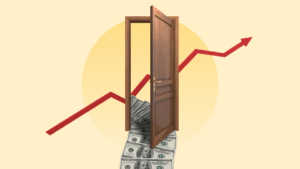Mortgage interest rate forecast for 2026: Rates may finally fall below 6%

Mortgage rates are unlikely to return to their pandemic lows in 2026, but they could still deliver some relief to borrowers. It’s possible that rates will even fall below the 6% threshold.
“I expect the average 30-year fixed rate to fall below 6% for the first time since the summer of 2022,” says Ted Rossman, Bankrate senior industry analyst. “It could go as low as 5.5%, given anticipated Fed rate cuts and a recession scare. But stubbornly high inflation readings and rumblings of a less independent Fed could apply upward pressure at other times of the year. The average 30-year fixed mortgage rate should bounce around 6% — sometimes a little lower, sometimes a little higher — throughout much of 2026.”
The average 30-year fixed mortgage rate should bounce around 6% — sometimes a little lower, sometimes a little higher — throughout much of 2026.— Ted Rossman, Bankrate Senior Industry Analyst
Bankrate’s 2026 mortgage forecast, with industry insights
-
Projected 2026 average: 6.1%
(a 0.2 percentage point decrease from mid-December 2025) -
Projected 2026 low: 5.7%
(lowest level since August 2022) -
Projected 2026 high: 6.5%
(highest level since September 2025)
Mortgage rates have taken borrowers on a wild ride. The pandemic dramatically underscored what drives mortgage markets: Bad news pushes them down, and terrible news sends them to historic lows. In 2020, the Federal Reserve slashed rates to zero. And 10-year Treasury yields, which are the closest proxy for mortgage rates, fell to record lows.
The result? For parts of 2020 and 2021, American homeowners could lock in 30-year mortgages at less than 3%. That created a housing boom and a wave of refinancings.
Then, in 2022, as inflation surged, the Fed reversed course. Treasury yields rose sharply, and mortgage rates shot up along with them. That led to a “housing recession” as home sales sputtered.
While no one expects mortgage rates below 6% to fix all that ails the U.S. housing market, lower rates certainly would spur some positive activity. Long-term renters might be more eager to become first-time buyers, and locked-in homeowners might prove willing to finally move.
“Slightly lower rates and slower price growth should improve affordability a little, which could bring more buyers into the market,” says Lisa Sturtevant, chief economist for Bright MLS, a listing service in the mid-Atlantic region. “[2026] is still going to be a transition year, however, and homebuyers and sellers are still going to be cautious.”
Mortgage rate forecasts are complicated by all sorts of countervailing economic winds. Stubbornly high inflation readings and rumblings of a less independent Fed could apply upward pressure on mortgage rates. A weaker job market would push mortgage rates down. Another factor is the spread between 10-year Treasury rates and mortgage rates. That gap has widened in recent years as mortgage investors have demanded a richer risk premium.
“This is just a best guess,” Rossman says. “Things don’t always move in a straight line. They don’t move directly in line with what the 10-year Treasury is doing. There is just so much intrigue about what’s happening with the Fed, what’s happening with the economy.”
What happened to mortgage rates in 2025
At the start of 2025, 30-year mortgage rates were north of 7%. They drifted down a bit from there, but rates remained above 6.5% for most of the year. Then, in early September, the U.S. labor market finally showed signs of weakness. That pushed mortgage rates below 6.5% — they hit a 2025 low of 6.25% in late October, according to Bankrate’s national survey of lenders.
How Bankrate’s forecast last year played out
Mortgage rates are notoriously difficult to forecast: They fell farther than anyone expected during the pandemic, then rose higher than anticipated as the Fed began fighting inflation. That said, Bankrate’s mortgage rate forecast for 2025 proved spot-on.
“The average 30-year fixed mortgage rate will spend most of the year in the 6s, with a short-lived spike above 7%, but never getting below 6%,” Greg McBride, Bankrate’s former chief financial analyst, predicted a year ago. “Continued economic growth and worries about inflation and government debt will keep mortgage rates elevated.”
What consumers need to know about mortgage rates in 2026
If you’re considering a home loan in 2026, here’s how the mortgage forecast might affect your finances:
- The aspiring homeowner: Buying a home lately has been tough. Home prices keep setting records, and mortgage rates are well above their pandemic lows. A gradual decline in rates would boost your buying power. But beware: A dip below 6% could also bring new buyers into the market, which would mean more competition for homes — and perhaps even higher prices.
- The homeowner who bought in late 2023: There was a moment in the not-too-distant past when mortgage rates were at 8%. And for about four months in 2023, they were at 7.25% or higher. If you bought then, a mortgage refinance could be in the cards in 2026. For example, let’s say you borrowed $400,000 at 7.25%, for a monthly principal-and-interest payment of $2,729. If rates fall to 6% this year, your new payment at that rate could be $2,398 — a savings of $331 a month, and probably enough to merit a refinancing.
- The homeowner who’s sitting pretty: Millions of Americans locked in super-low mortgage rates in 2020 and 2021, and those homeowners are reluctant to move. Say you borrowed $400,000 in 2021 at 3%. Your monthly principal-and-interest payment on a 30-year loan is just $1,686. Even if current mortgage rates dip to 6%, taking a loan for the same amount on a different home would cause your payment to spike to $2,398.
No matter your situation, and no matter which direction mortgage rates go this year, some basic advice holds true:
- Comparison-shop lenders: Mortgage offers can vary widely from one lender to the next. That doesn’t mean anything nefarious is happening; it’s simply that mortgages are complicated products. Compare offers from at least three (and preferably five) lenders. By conducting an online search, you might save thousands of dollars by finding the one offering a lower rate and more competitive fees.
- Get your credit in shape: Though it’s possible to get a mortgage with a credit score of 620 or even lower, the best deals on mortgages go to borrowers with a 780 score or higher. Here are our strategies to improve credit before applying for a mortgage.
- Don’t get too caught up trying to time rates: Mortgage rates are famously difficult to predict, so if you’re ready to buy a home, it’s likely better to go ahead and lock in your rate. Loan officers and real estate agents often use the phrase “marry the house, date the rate” — meaning, buy the house that’s right for you when you can, and if mortgage rates fall in the future, you can always refinance to a lower rate.
Why we ask for feedback Your feedback helps us improve our content and services. It takes less than a minute to complete.
Your responses are anonymous and will only be used for improving our website.








